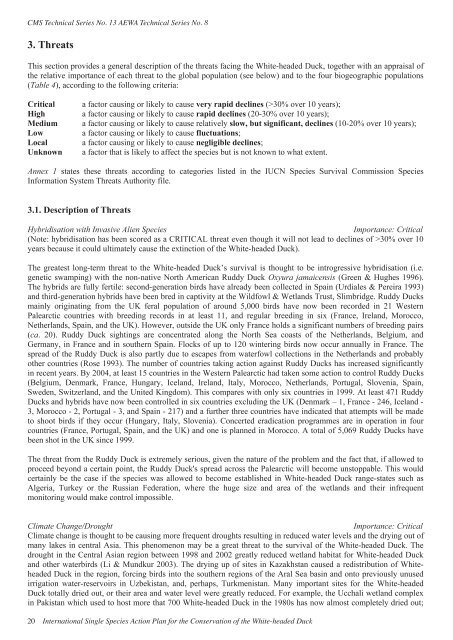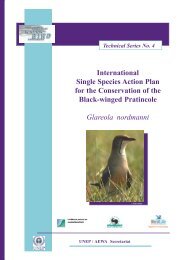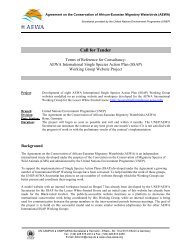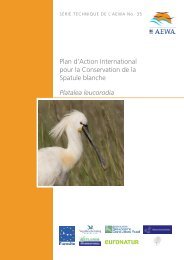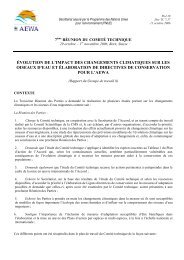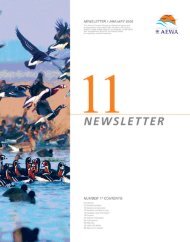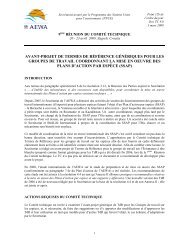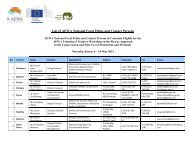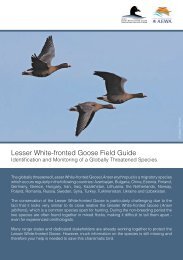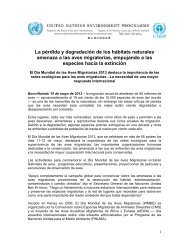International Single Species Action Plan for the Conservation - AEWA
International Single Species Action Plan for the Conservation - AEWA
International Single Species Action Plan for the Conservation - AEWA
You also want an ePaper? Increase the reach of your titles
YUMPU automatically turns print PDFs into web optimized ePapers that Google loves.
CMS Technical Series No. 13 <strong>AEWA</strong> Technical Series No. 8<br />
3. Threats<br />
This section provides a general description of <strong>the</strong> threats facing <strong>the</strong> White-headed Duck, toge<strong>the</strong>r with an appraisal of<br />
<strong>the</strong> relative importance of each threat to <strong>the</strong> global population (see below) and to <strong>the</strong> four biogeographic populations<br />
(Table 4), according to <strong>the</strong> following criteria:<br />
Critical a factor causing or likely to cause very rapid declines (>30% over 10 years);<br />
High a factor causing or likely to cause rapid declines (20-30% over 10 years);<br />
Medium a factor causing or likely to cause relatively slow, but significant, declines (10-20% over 10 years);<br />
Low a factor causing or likely to cause fluctuations;<br />
Local a factor causing or likely to cause negligible declines;<br />
Unknown a factor that is likely to affect <strong>the</strong> species but is not known to what extent.<br />
Annex 1 states <strong>the</strong>se threats according to categories listed in <strong>the</strong> IUCN <strong>Species</strong> Survival Commission <strong>Species</strong><br />
In<strong>for</strong>mation System Threats Authority file.<br />
3.1. Description of Threats<br />
Hybridisation with Invasive Alien <strong>Species</strong> Importance: Critical<br />
(Note: hybridisation has been scored as a CRITICAL threat even though it will not lead to declines of >30% over 10<br />
years because it could ultimately cause <strong>the</strong> extinction of <strong>the</strong> White-headed Duck).<br />
The greatest long-term threat to <strong>the</strong> White-headed Duck’s survival is thought to be introgressive hybridisation (i.e.<br />
genetic swamping) with <strong>the</strong> non-native North American Ruddy Duck Oxyura jamaicensis (Green & Hughes 1996).<br />
The hybrids are fully fertile: second-generation birds have already been collected in Spain (Urdiales & Pereira 1993)<br />
and third-generation hybrids have been bred in captivity at <strong>the</strong> Wildfowl & Wetlands Trust, Slimbridge. Ruddy Ducks<br />
mainly originating from <strong>the</strong> UK feral population of around 5,000 birds have now been recorded in 21 Western<br />
Palearctic countries with breeding records in at least 11, and regular breeding in six (France, Ireland, Morocco,<br />
Ne<strong>the</strong>rlands, Spain, and <strong>the</strong> UK). However, outside <strong>the</strong> UK only France holds a significant numbers of breeding pairs<br />
(ca. 20). Ruddy Duck sightings are concentrated along <strong>the</strong> North Sea coasts of <strong>the</strong> Ne<strong>the</strong>rlands, Belgium, and<br />
Germany, in France and in sou<strong>the</strong>rn Spain. Flocks of up to 120 wintering birds now occur annually in France. The<br />
spread of <strong>the</strong> Ruddy Duck is also partly due to escapes from waterfowl collections in <strong>the</strong> Ne<strong>the</strong>rlands and probably<br />
o<strong>the</strong>r countries (Rose 1993). The number of countries taking action against Ruddy Ducks has increased significantly<br />
in recent years. By 2004, at least 15 countries in <strong>the</strong> Western Palearctic had taken some action to control Ruddy Ducks<br />
(Belgium, Denmark, France, Hungary, Iceland, Ireland, Italy, Morocco, Ne<strong>the</strong>rlands, Portugal, Slovenia, Spain,<br />
Sweden, Switzerland, and <strong>the</strong> United Kingdom). This compares with only six countries in 1999. At least 471 Ruddy<br />
Ducks and hybrids have now been controlled in six countries excluding <strong>the</strong> UK (Denmark – 1, France - 246, Iceland -<br />
3, Morocco - 2, Portugal - 3, and Spain - 217) and a fur<strong>the</strong>r three countries have indicated that attempts will be made<br />
to shoot birds if <strong>the</strong>y occur (Hungary, Italy, Slovenia). Concerted eradication programmes are in operation in four<br />
countries (France, Portugal, Spain, and <strong>the</strong> UK) and one is planned in Morocco. A total of 5,069 Ruddy Ducks have<br />
been shot in <strong>the</strong> UK since 1999.<br />
The threat from <strong>the</strong> Ruddy Duck is extremely serious, given <strong>the</strong> nature of <strong>the</strong> problem and <strong>the</strong> fact that, if allowed to<br />
proceed beyond a certain point, <strong>the</strong> Ruddy Duck's spread across <strong>the</strong> Palearctic will become unstoppable. This would<br />
certainly be <strong>the</strong> case if <strong>the</strong> species was allowed to become established in White-headed Duck range-states such as<br />
Algeria, Turkey or <strong>the</strong> Russian Federation, where <strong>the</strong> huge size and area of <strong>the</strong> wetlands and <strong>the</strong>ir infrequent<br />
monitoring would make control impossible.<br />
Climate Change/Drought Importance: Critical<br />
Climate change is thought to be causing more frequent droughts resulting in reduced water levels and <strong>the</strong> drying out of<br />
many lakes in central Asia. This phenomenon may be a great threat to <strong>the</strong> survival of <strong>the</strong> White-headed Duck. The<br />
drought in <strong>the</strong> Central Asian region between 1998 and 2002 greatly reduced wetland habitat <strong>for</strong> White-headed Duck<br />
and o<strong>the</strong>r waterbirds (Li & Mundkur 2003). The drying up of sites in Kazakhstan caused a redistribution of Whiteheaded<br />
Duck in <strong>the</strong> region, <strong>for</strong>cing birds into <strong>the</strong> sou<strong>the</strong>rn regions of <strong>the</strong> Aral Sea basin and onto previously unused<br />
irrigation water-reservoirs in Uzbekistan, and, perhaps, Turkmenistan. Many important sites <strong>for</strong> <strong>the</strong> White-headed<br />
Duck totally dried out, or <strong>the</strong>ir area and water level were greatly reduced. For example, <strong>the</strong> Ucchali wetland complex<br />
in Pakistan which used to host more that 700 White-headed Duck in <strong>the</strong> 1980s has now almost completely dried out;<br />
20 <strong>International</strong> <strong>Single</strong> <strong>Species</strong> <strong>Action</strong> <strong>Plan</strong> <strong>for</strong> <strong>the</strong> <strong>Conservation</strong> of <strong>the</strong> White-headed Duck


